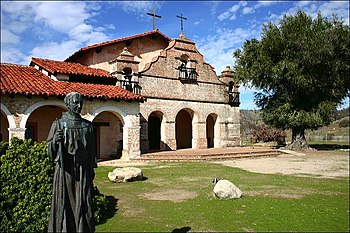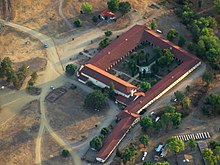Mission San Antonio de Padua
 The reconstructed Mission San Antonio de Padua as it appeared in 2006; construction on the Mission first began in 1810. The baked brick Campanario is unique among California Missions. | |
| Location | near Jolon, Monterey County, California |
|---|---|
| Coordinates | 36°00′54″N 121°15′00″W / 36.01500°N 121.25000°W |
| Name as founded | La Misión de San Antonio de Padua[1] |
| English translation | The Mission of Saint Anthony of Padua |
| Patron | Saint Anthony of Padua[2] |
| Nickname(s) | "Mission of the Sierras"[citation needed] |
| Founding date | July 14, 1771[3] |
| Founding priest(s) | Father Junípero Serra[4] |
| Founding Order | Third[2] |
| Military district | Third[5] |
| Native tribe(s) Spanish name(s) | Salinan |
| Native place name(s) | Telhaya[6] |
| Baptisms | 4,419[7] |
| Marriages | 1,142[7] |
| Burials | 3,617[7] |
| Secularized | 1834[2] |
| Returned to the Church | 1862 |
| Governing body | Roman Catholic Diocese of Monterey |
| Current use | Parish Church |
| Designated | 1976 |
| Reference no. | 76000504[8] |
| Reference no. | 232[9] |
| Website | |
| http://www.missionsanantonio.net | |
Mission San Antonio de Padua is a Spanish mission established by the Franciscan order in present-day Monterey County, California, near the present-day town of Jolon. Founded on July 14, 1771, it was the third mission founded in Alta California by Father Presidente Junípero Serra. The mission was the first use of fired tile roofing in Upper California.[4] Today the mission is a parish church of the Diocese of Monterey and is no longer active in the mission work which it was set up to provide.[10][11]
History
[edit]Beginnings of the Mission
[edit]

This section needs additional citations for verification. (April 2019) |
Mission San Antonio de Padua was the third Mission to be founded in Alta California, and was located along the very earliest routing of the Camino Real. This mission was located on a site which was unfortunately somewhat remote from the more reliable water source of what later became known as the Salinas River. In that very early year of the missions, the later more favorable routing of the Camino Real, more closely aligning with the course of the Salinas River, had not yet been discovered or established.[12]
Father Junipero Serra claimed the site on July 14, 1771, and dedicated the Mission to Saint Anthony of Padua. Saint Anthony was born in 1195 in Lisbon, Portugal and is the patron saint of the poor. Father Serra left Fathers Miguel Pieras and Buenaventura Sitjar behind to continue the building efforts, though the construction of the church proper did not actually begin until 1810.
In 1805, the native people at the mission, mostly Northern Salinan (Antoniano) but also some Yokuts and Esselen,[13] had increased to 1,300. By 1810, only 178 Native Americans were living at the Mission,[14] In 1834, after secularization[13] there were 150 Mission Indians remaining. No town grew up around the mission, as was usual at other missions.
In 1845, Mexican Governor Pío Pico declared all mission buildings in Alta California for sale, but no one bid for Mission San Antonio. In 1863, after nearly 30 years, the Mission was returned to the Catholic Church.[13] In 1894, roof tiles were salvaged from the property and installed on the Southern Pacific Railroad depot located in Burlingame, California, one of the first permanent structures constructed in the Mission Revival Style.
Restoration
[edit]This section needs to be updated. (January 2021) |

The first attempt to rebuild the Mission came in 1903 when the California Historical Landmarks League began holding outings at San Antonio. "Preservation and restoration of Mission San Antonio began. The Native Sons of the Golden West donated $1,400. Tons of debris were removed from the interior of the chapel.the mission was restored 2 times. Breaches in the side wall were filled in."[15] Unfortunately, the earthquake of 1906 seriously damaged the building. In 1928, Franciscan friars held services at San Antonio de Padua. It took nearly 50 years to completely restore the Mission. The State of California is requiring a $12–15 million earthquake retrofit that must be completed by 2015, or the mission will be closed. As of 2011, there were 35 private families keeping the mission open. There is an active campaign to raise funds for the retrofit.[16]
Current use of the old San Antonio Mission
[edit]Despite its being still referred to as a mission, the Mission San Antonio de Padua is no longer active in Catholic missions and has become more focused as a parish church, fundraiser location, and tourist attraction.[10] In 2005, the Franciscan Friars turned over the mission's caretaking and ownership to the Diocese of Monterey.[10] Under the leadership of the Diocese of Monterey, Mission San Antonio de Padua transformed into a Catholic parish which also hosts group gatherings, gift shops and a museum with picnic grounds.[10]
Present day
[edit]
Today, the nearest city is King City, nearly 29 miles (47 kilometers) away; Jolon, a small town, is located six miles (10 km) from the Mission. Historians consider the Mission's pastoral location in the valley of the San Antonio River along the Santa Lucia Mountains as an outstanding example of early mission life.
The mission is surrounded by the Fort Hunter Liggett Military Reservation, which was acquired by the U.S. Army from the Hearst family during World War II to train troops. Additional land was acquired from the Army in 1950 to increase the mission area to over 85 acres (34 hectares). This fort is still actively training troops today.
Mission San Antonio de Padua is one of the designated tour sights of the Juan Bautista de Anza National Historic Trail.
As of 2013, Franciscan Friar Jeff Burns OFM, is in charge of the Mission.


In popular culture
[edit]- The 1965 horror film Incubus was partly filmed at the Mission. The writer and director, Leslie Stevens, concerned that the Mission authorities would not allow the film to be shot there because of the subject matter, concocted a cover story that the film was called Religious Leaders of Old Monterey, and presented a script that was about monks and farmers. He was helped in this deception by the fact that the film was shot entirely in Esperanto.[17]
- The Mission was featured by Huell Howser in Road Trip Episode 147[18]
See also
[edit]- The Hacienda (Milpitas Ranchhouse) – the nearby Mission Revival Style guest-ranch house [now hotel] built in 1930 by W.R. Hearst.
- Juan Bautista de Anza National Historic Trail
- List of Spanish missions in California
- List of tourist attractions in Monterey County, California
- Mission Nuestra Señora de la Soledad – next mission located north
- Mission San Miguel Arcángel – next mission located south
- Spanish missions in California
- USNS Mission San Antonio (T-AO-119), a Buenaventura-Class fleet oiler built in 1944
Further reading
[edit]- Sitjar, Bonaventura (1861). Vocabulary of the language of San Antonio mission, California. Trübner. Retrieved 25 August 2012.
References
[edit]Bibliography
[edit]- Forbes, Alexander (1839). California: A History of Upper and Lower California. Smith, Elder and Co., Cornhill, London.
- Krell, Dorothy, ed. (1979). The California Missions: A Pictorial History. Sunset Publishing Corporation, Menlo Park, CA. ISBN 0-376-05172-8.
- Jones, Terry L. and Kathryn A. Klar (eds.) (2007). California Prehistory: Colonization, Culture, and Complexity. Altimira Press, Landham, MD. ISBN 978-0-7591-0872-1.
{{cite book}}:|author=has generic name (help) - Leffingwell, Randy (2005). California Missions and Presidios: The History & Beauty of the Spanish Missions. Voyageur Press, Inc., Stillwater, MN. ISBN 0-89658-492-5.
- Paddison, Joshua, ed. (1999). A World Transformed: Firsthand Accounts of California Before the Gold Rush. Heyday Books, Berkeley, CA. ISBN 1-890771-13-9.
- Ruscin, Terry (1999). Mission Memoirs. Sunbelt Publications, San Diego, CA. ISBN 0-932653-30-8.
- Yenne, Bill (2004). The Missions of California. Advantage Publishers Group, San Diego, CA. ISBN 1-59223-319-8.
Notes
[edit]- ^ Leffingwell, p. 99
- ^ a b c Krell, p. 101
- ^ Yenne. p. 40
- ^ a b Ruscin, p. 196
- ^ Forbes, p. 202
- ^ Ruscin, p. 195
- ^ a b c Krell, p. 315: as of December 31, 1832; information adapted from Engelhardt's Missions and Missionaries of California.
- ^ National Register of Historic Places – Monterey County
- ^ "Mission San Antonio de Padua". Office of Historic Preservation, California State Parks. Retrieved 2012-11-23.
- ^ a b c d "San Antonio de Padua Key Facts | California Missions Resource Center".
- ^ "History of California Mission San Antonio de Padua".
- ^ | Molera, E. J. The March of Portolá and the Discovery of the Bay of San Francisco (1909) p.35, Wordsworth Editions, ASIN : B002RKT4HG! Access date: April 5, 2021.
- ^ a b c "San Antonio de Padua", California Missions Resource Center
- ^ "The History of our Mission", Mission San Antonio de Padua
- ^ California Missions and Their Romances, Fremont Older
- ^ "Campaign for the Preservation of Mission San Antonio de Padua". Retrieved July 15, 2013.
- ^ Miller, John M. "Incubus" (TCM article)
- ^ "Fort Hunter Liggett – Road Trip with Huell Howser (147) – Huell Howser Archives at Chapman University".
External links
[edit]- Mission San Antonio de Padua official website
- Fort Hunter Liggett official website
- Monterey County Historical Society
- Early photographs, sketches of Mission San Antonio de Padua, via Calisphere, California Digital Library
- Early History of the California Coast, a National Park Service Discover Our Shared Heritage Travel Itinerary
- Indigenous educators fight for an accurate history of California
- Official U.S. National Park Service Juan Bautista de Anza National Historic Trail website
- Howser, Huell (December 8, 2000). "California Missions (104)". California Missions. Chapman University Huell Howser Archive.
- Tourist attractions in Monterey County, California
- Spanish missions in California
- 1771 in Alta California
- Churches in Monterey County, California
- Museums in Monterey County, California
- History museums in California
- Religious museums in California
- 1771 establishments in Alta California
- Religious organizations established in 1771
- Roman Catholic churches completed in 1810
- History of Monterey County, California
- California Historical Landmarks
- Churches on the National Register of Historic Places in California
- Roman Catholic Diocese of Monterey in California
- Salinan people
- Santa Lucia Range
- National Register of Historic Places in Monterey County, California
- Junípero Serra
- 19th-century Roman Catholic church buildings in the United States


